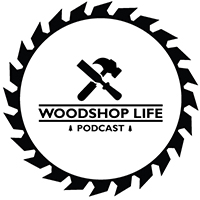This Episodes Questions:
Brian’s Questions:
I’m hoping to enhance my beginner(ish) skills by going back to the basics and making boxes. Any advice on getting perfect miters for small parts? I’ve got a table saw sled but my small DEWALT job site saw gives me issues finding 45. Any advice on reasonably priced dovetail saws or alternatives? Where do you source small parts like hinges and drawer pulls for a fair price? Many Thanks, Dave
Hi guys, Your podcast is excellent and I have been able to put your advice to use on multiple occasions. I know you have talked edge banding before but I still need a little help. I do quite a bit of plywood with a roughly 3/4 to half inch thick edge band trimmed with a flush cut bit with a vee groove to give it a little decorative look as well as make it easier to sand flush. The problem I’m having is I seem to struggle with getting my edge banding perfectly tight to the plywood so the seem is visible some of the time. I’ve tried jointing the edge banding but not the plywood because plywood through a jointer seems like a bad idea and that didn’t seem to help. When only doing a few pieces I’ve clamped it to the shelf with slightly better results but often do between 8 and 15 8 foot long boards at a time so I don’t have the clamps or space to clamp everything. Currently I glue then pin nail with my 23 ga nailer. What am I doing wrong? I’m hoping guy has some good insight here since he works in a more commercial/ production environment and that’s more along the lines of what I do. Thanks, Mike Arntz
Guy’s Questions:
Hello all, I recently stumbled on you podcast and greatly enjoy the format. I am recently new to woodworking partly out of boredom during Covid. My initial projects were too ambitious for my skill set, yet I forged ahead and learned more from my mistakes than what I did right. Since I live in Asia, hardwoods are easy to come by and recently someone gave me a 4″ thick slab of Padauk. About 6 ft long. I can’t imagine how much this would cost in NorthAmerica. I am making a breakfast table out it. Wood looks stunning but I understand it will darken with age. I will eventually move back home and would like to make an old style butcher block. The massive one butchers actually used to cut meat. However, plans or information on how to go about it is very sparse. I was thinking milling logs into 4×4 and fastening them end grain up somehow. I see some use long carriage bolts to hold the thing together. Any words of advice is much appreciated. I imagine this might not be a project you have done in the past, but how would you go about it? Thanks in advance, love your show and listen to your podcast when I go biking. Bert Plourde
I am building a floating shelf bar for my son. It’s a 3 1/2″ torsion box with red oak ply top and 3/4″ redwood edging. It will be stained / dyed dark brown. I am trying to decide on a top coat. Shellac is easy and easily repaired. Oil will look good but provides minimal protection. “Shop” finish (oil/varnish/solvent) would probably work well. Maybe something else? Thoughts? Ron Guritzky
Huy’s Questions:
Hey guys, I love your podcast and listen to it all day at work. While I don’t do fine furniture work like you do I’m really trying to get better and do more. For a background I was a commercial carpenter turned finish carpenter and am trying to work my way up to fine finish work. I’m doing more built ins and that kind of work and am just curious as to what you recommend for tools. Right now I have a grizzly planer, benchtop jointer, mitersaw, jobsite saw, dovetail jig, and a decent collection of hand tools. I’m going to pick up an older craftsman 113 table saw and am looking for recommendations on an affordable fence. Current I work in both my shop and on site so I need to be fairly mobile but am also working on gearing up to do more shop work. Any additional advice is welcome. I also forgot to add I have mobile dust collection, and a grizzly mobile router table. Check out my profile for some of the work I’ve done. Thanks for the great podcast. -Mike Arntz
Hey fellas. I’m loving the podcast as usual! Keep up the great content. Here’s my question: one of the best parts of living near Silicon Valley, is the availability of old work benches from defunct tech companies. I got the one in the picture for $40 with the solid metal frame and solid maple butcher block style top. I added the plywood drawers in the bottom and I’ve been using this as a outfeed table and assembly table. However, I’ve noticed that the top is not perfectly flat, and that it is especially lower around the edges. I was considering taking the top off, ripping it into three pieces, so that it will fit through my 13 inch planer, and then using dominoes to glue it back together to try to get it flat. Do you think this is a good method or is there some better way to accomplish the same thing? I was also planning to drill dog holes into the top. However, on a recent episode, you talked about the limitations of many of the dogs on thicker tops. The current thickness is about 1 1/2 inches. Even after planing it down as previously described, I think the top will end up being at least an inch and a quarter thick. Are there dogs available that would work with a top that thick that you can recommend? @firelightwoodworks
